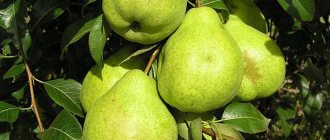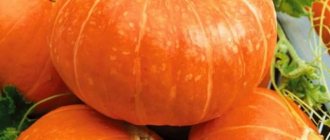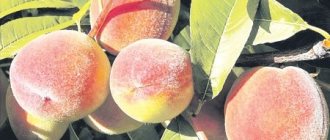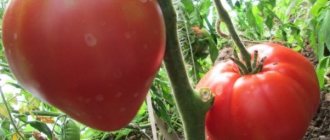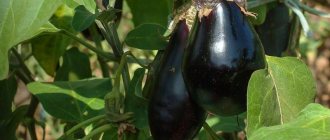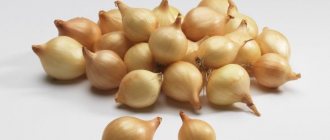Marble pumpkin has distinctive features: the surface is covered with veins, the color is emerald green, the peel is wrinkled, as a result of which the variety resembles marble in appearance. The culture belongs to the mid-late crop, quite sweet (13% sugar), rich in microelements, vitamins E, C, A.
marble pumpkin
Marble pumpkin is easy to care for
Marbled pumpkin has juicy sweet pulp
general characteristics
Marbled pumpkin has been grown in Russia for a long period of time, therefore it is considered a famous variety. The popularity of the pumpkin variety is based on the stability of high yield and excellent taste (the pulp is sweet and juicy). After the formation of seedlings, 125-140 days pass before harvesting.
The vines of the plant are quite powerful, long and strong, since the pumpkin is a large-fruited pumpkin. The leaves are uncut, large, dark green. The flowers are bright yellow to attract pollinating insects.
The variety is frost-resistant and drought-resistant, which is why it is grown in almost all regions of the country. Despite this, the crop is heat-loving (in cool weather conditions and lack of light, the level of sugar content decreases and the pulp changes its structure). For this reason, it is better to grow the variety in the south.
Advantages and disadvantages
The main advantages of Marble Pumpkin:
- high productivity;
- fruit size;
- unpretentiousness of care;
- sweetness;
- pleasant aroma and taste;
- transportability;
- keeping quality;
- beautiful appearance;
- There is no cracking of the peel.
Flaws:
- shade intolerance;
- the need for constant fertilization.
Description of fruits
The external characteristics and taste of the Marble Pumpkin depend on climatic and weather conditions, as well as the level of care, so it is impossible to obtain exactly the same vegetables under different factors. The peculiarity of the peel is that it looks quite strong, but cuts easily.
Fruit characteristics:
- the taste of the pulp is sweet, unusual;
- juiciness – high;
- astringency, no sourness;
- the aroma increases with storage and has nutmeg notes;
- peel color – gray-dark, in a very ripe state – green-gray;
- the average weight of pumpkins is 5-10 kg;
- shape – round flattened;
- the surface of the crust contains specks (occur 7-10 days before full ripening) and veins;
- the seeds are creamy in color, size – up to 3 cm;
- The structure of the pulp is tender, the color is pronounced orange.
Productivity
Marbled pumpkin is considered a high-yielding variety. With proper care and compliance with agrotechnical requirements, from 1 sq. m you can get up to 20 kg of vegetables.
Use of fruits
The variety is universal, therefore it is used for the following purposes:
- preparing first and second courses (porridge, puree soups, casseroles, stews, etc.);
- production of juice, baby food;
- baking pies, preparing desserts;
- adding to salads;
- animal feed.
Marble pumpkin is full of useful substances, so the pulp is used in cosmetology (smoothes wrinkles) and medicine (has a positive effect on the liver, improves visual acuity, restores the functionality of the gastrointestinal tract). The seed part is used as food and is used to remove and suppress helminths in the human body (destroys worms).
Harvest and storage
Harvesting of the mid-season muscat variety usually occurs at the end of summer, and in unfavorable climate regions it does not begin until autumn. Before harvesting vegetables, perform certain actions:
- wait until the pumpkin leaves dry completely;
- choose a warm and clear day to collect vegetables;
- when trimming the stalk, leave a tail at least 4 cm long.
Whole and undamaged vegetables are selected for storage. To preserve vegetables, choose a dry room where the temperature does not drop below 12 °C. If these conditions are met, the vegetable retains its visual appeal and gastronomic value for 1 year.
Features of cultivation
The main condition for successful cultivation of Marble Pumpkin is soil fertility. If the soil is poor, you will have to constantly feed it. The area for planting must be prepared in the fall - digging to the depth of a shovel, adding manure or humus.
Preparing the landing site
Productivity largely depends on the chosen location - the area should be well lit, free from drafts and shade. The best soil is loam and sandy loam. If the soil is highly acidic, lime, peat and wood ash are added to it.
How to properly prepare the site:
- dig up the soil in the fall, adding organic fertilizers;
- in the spring, dig up the soil again (slightly, just to loosen it);
- add compost;
- to improve drainage properties, it is recommended to add sawdust or sand directly during planting;
- To prevent the pumpkin from getting sick, it is advisable to disinfect the soil (you can buy Fundazol or water it with a weak solution of manganese);
- remove the root system of weeds and household waste from the site.
Seed preparation
Seed material is prepared a couple of days before planting in the ground or for seedlings. Be sure to manually sort through each grain, discarding damaged, spotted and hollow elements. Marbled pumpkin has a unique property - a high level of germination, which eliminates the need for pre-germination. Therefore, preparatory activities include the following:
- warm the seeds at a temperature of 40-45 degrees (can be placed in the oven for 3-4 hours or placed on a heating radiator for 12 hours);
- soak the seeds overnight in a solution of wood ash (1 tablespoon mixed with 0.5 liters of warm water), leave in a warm place;
- dry the seed material.
Planting seedlings
Pumpkin is grown using seedlings in the northern regions of Russia. For planting seeds, a variety of containers are used - store-bought peat cups, plastic cups, tetrapacks for dairy and fermented milk products. Before adding soil, containers (except peat containers) are thoroughly washed and dried. It is mandatory to make small holes in the bottom for soil drainage.
The following can be used as primer:
- Ready-made universal substrate from a specialized store. Such soil has the required level of acidity and is saturated with useful substances, which speeds up the process of grain pecking and improves seedling performance.
- Homemade mixture. What you will need: garden soil - 4 parts, sawdust - 1 part, humus - 1 part, wood ash - half a part. To prevent contamination, the prepared composition is disinfected with a solution of potassium permanganate.
Rules for planting seeds and growing seedlings:
- pour a small layer of pebbles into the prepared container (again for drainage);
- add soil almost to the top;
- moisten the soil with a spray bottle;
- insert 2 seeds;
- sprinkle with soil;
- cover with thick plastic wrap;
- place on the sunny side;
- after 10-12 days, add a mineral complex or organic fertilizer;
- The seedlings are ready for picking in 20-21 days.
Other rules that are important to follow:
- throughout the entire time it is necessary to monitor the level of humidity, periodically watering the seedlings;
- when the first shoots hatch, the film is removed;
- Daylight hours for seedlings should be 14-16 hours, so in the dark the containers are placed under lamps.
When the first 1-2 leaves appear, it is necessary to thin out the seedlings, that is, remove the weak sprout and leave the strong one. This must be done carefully so as not to damage the healthy root. You can't pull out the shoot. It is cut with nail scissors just below the surface of the soil.
Planting in open ground
Seeds are planted directly on street beds in warm regions. There is no need to germinate the grains, but you should follow the preparation rules. The soil temperature in the garden should vary from 13 to 18 degrees.
Planting steps:
- dig holes up to 6 cm deep in the area;
- the distance between them should be at least 60 cm, no more than 1 meter;
- pour two liters of boiling water into each hole (for disinfection);
- when the water is absorbed, place 2 grains at a time;
- sprinkle with soil mixed with organic matter (humus);
- mulch.
Mulching is necessary to maintain moisture. If frost or a decrease in air temperature is expected, the seeds are covered with film or a plastic bottle.
Watering
The crop needs to be watered until the fruits are half-ripe. At the initial stages, young bushes require about 2 liters of water, then the amount of liquid gradually increases to 5 liters.
It is forbidden to pour water on the leaves - only on the surface of the ground. It is advisable to use rainwater or settled water.
Thinning and weeding
Thinning is carried out after the formation of 3 leaves. It is necessary to adhere to the same rules as when thinning seedlings.
Weeds have a detrimental effect on pumpkin crops - they spread infections, collect insects, infect them with diseases, and absorb moisture and nutrients. For these reasons, weeds are destroyed.
You need to pull out the grass every week until the vines and pumpkin foliage cover the entire area. Along with weeding, loosening is also carried out. It is advisable to do these procedures after watering the next day.
Feeding
This is an important agrotechnical condition. Fertilizers are applied 2 times a month. For this purpose, the Marbled Pumpkin’s favorite fertilizer, mullein, is usually used. It is diluted with water in a ratio of 1:20.
Additionally, you can use growth stimulants, nettle tincture, aloe juice, yeast solutions, chicken droppings, and onion peel decoction.
Bush formation
The lashes of this pumpkin are quite long, so high-quality formation of the bush is required:
- it is advisable to remove stepchildren;
- You cannot leave more than 3 fruits on each stem;
- if the whip is very long, it is pinched;
- The lashes also need to be sprinkled with soil, which eliminates the risk of tangling.
Recommendations from gardeners
Growing Tips:
- It is necessary to follow the rules of crop rotation. You cannot grow Marble Pumpkin after cucumbers, squash and zucchini. The best previous vegetable is onion, legumes.
- If seedlings are grown in greenhouse conditions, be sure to install a ventilation system or open the greenhouse for ventilation. Otherwise, the risk of fungal diseases increases.
- It is necessary to irrigate the beds in the evening or early morning. It is strictly forbidden to water the crop during the day, as sunburn is possible.
- Do not allow excessive moisture, this leads to rot.
- The variety loves mineral supplements, so add a solution of wood ash.
- It is advisable to loosen to a depth of 7-10 cm.
- It is allowed to fertilize the soil until mid-August, no more.
Mr. Summer Resident recommends: marble pumpkin recipes
Due to its taste and high sugar content, marbled pumpkin is widely used in cooking.
It is eaten raw and cooked, without deteriorating the taste.
Marbled pumpkin bread
Prepared for a large family, you can take 2 times less food.
| Ingredients | Weight (g) |
| Flour | 600 |
| Sugar | 200 |
| Salt | 10 |
| Dry yeast | 15 |
| Milk | 300 |
| Water | 150 |
| Butter | 100 |
| marble pumpkin | 300 |
| Starch | 30 |
| Vegetable oil | 10 |
Preparation
- Mix 2/3 milk, yeast and water. Leave for 15 minutes. Knead the dough and put it in a warm place again to rise. While it is rising, prepare the pumpkin filling. Pumpkin puree is made.
- Pour the remaining slightly warm milk, softened butter into a large bowl and add the mashed vegetable, starch, and sugar. The mass is kneaded well, then heated to 30 °C.
- The risen dough is rolled out on the table, adding flour so that it does not stick. Lay out and distribute the layer. First, wrap 1/3 of the dough on the left so that the pumpkin remains inside. Repeat the same procedure on the right. Then fold the other side again to make a square. The dough becomes nine-layered. It is cut lengthwise into 2 parts, and then each of them into 3 strips, not completely.
- Each part is woven into a braid. Place in a mold greased with vegetable oil, one on top of the other. Leave to increase volume.
- Bake at +185 °C for approximately 35 minutes.
Marble casserole with cottage cheese and pumpkin
| Ingredients | Weight (g) |
| Pumpkin puree | 700 |
| Sour cream | 100 |
| Sugar | 170 |
| Eggs | 6 (pieces) |
| Milk | 100 |
| Orange zest | 5 |
| Corn starch | 150 |
| Cottage cheese | 500 |
Preparation
- To make pumpkin puree, scoop out the flesh of the pumpkin, wrap it in foil and bake in the oven until it is very soft. Then squeeze out the juice and grind it in a blender. Mix 2 eggs, 1 tablespoon of starch, 80 g of sugar and zest with the puree.
- Next, take any cottage cheese. If it is dry, then pour in milk. Beat cottage cheese with sugar, add eggs, starch and, if desired, poppy seeds.
- Prepare a baking dish by coating it with vegetable oil. Line it with paper. Alternately pour one spoon of cottage cheese into the center, then pumpkin puree, until all the cottage cheese is used and half of the puree is used.
- Preheat the oven to +170 °C. Bake for half an hour.
- At this time, prepare the filling by shaking 2 eggs. Add the remaining puree, a tablespoon of starch, sugar and sour cream, mix until smooth.
- Remove the casserole from the oven and pour the filling evenly. Then put it back for another 10 minutes.
After baking, remove and cool completely.
Pumpkin soup with scrambled egg and shrimp
| Ingredients | Weight (g) |
| Pumpkin puree | 200 |
| Cream 33% | 50 |
| Potato | 30 |
| Eggs | 1 PC) |
| Onion | 60 |
| Chicken bouillon | 100 |
| Green onions for garnish | 150 |
| Cilantro oil | 2 |
Preparation
- Chicken broth is mixed with pumpkin puree, cream and chopped onions are added.
- Boil the potatoes, cut them, and put them in the resulting liquid. Grind in a blender until pureed.
- Pour olive oil into a frying pan, after heating it, add the shrimp and fry until tender.
- Break the eggs into a cold saucepan, add 20 g of butter, salt, pepper, put on the fire and begin to mix.
- When heated, the eggs set and form a uniform consistency. Remove the pan and stir the contents again with a fork.
- Pumpkin puree is poured into a deep plate, scramble and shrimp are placed on top, and decorated with herbs.
Diseases and pests
Marbled pumpkin is not a pampered crop, therefore, if agricultural practices are followed, it is not subject to disease and attack from pests and insects. Under other conditions, the following diseases most often occur and affect the following pests:
- Powdery mildew is characterized by a white coating on the leaf blade. The drug Topaz, a colloidal sulfur solution, will help get rid of it.
- Bacteriosis covers the plant with brown spots. Treatment is spraying with copper-based preparations.
- White fungal rot is localized on the above-ground part of the crop and is distinguished by a flake-like coating. To eliminate the disease, treatment with a solution of copper sulfate (0.5%) is required.
- Spider mites are easily recognized because the insect forms webs on the plant. For treatment, insecticides and folk remedies (alkaline garlic or onion tincture) are used.
- The melon aphid is localized on the ovaries and leaves on the inside. For the fight, the same means are used as in the previous case.
- Slugs eat ovaries, flowers, leaves, and stems. You can get rid of them using traps. To do this, wet rags and cabbage leaves are laid out next to the bush.
As preventive measures against diseases and pests, you need to do the following:
- adhere to the rules of agricultural technology and crop rotation;
- plant peppers and tobacco next to the pumpkin;
- do not plant the pumpkin densely;
- monitor the level of soil moisture;
- feed with fertilizers to increase the plant’s immunity;
- remove infected items daily;
- disinfect seeds, soil, planting containers;
- pull out weeds.
Further care
Further care for the muscat species includes thinning, watering, weeding and fertilizing.
Thinning
When 3 leaves appear on the plants, the plantings are thinned out, leaving only one of the 2-3 planted sprouts, the strongest, and the rest are removed. At the same time, they are not pulled out to avoid damage to the root system, but cut off.
Watering
The variety loves moisture
The marbled species loves moisture, so after planting, the seeds are watered every day until sprouts appear. A grown pumpkin requires watering as the soil dries out; the volume of water increases to 5 liters per bush. Water is poured strictly under the roots, and before the procedure the ground is loosened without touching the root system.
Weeding
Removing weeds directly affects the size of future fruits. Weeds take a large share of mineral nutrition, causing damage to developing young shoots. Weeding also makes it possible to clear the space between vegetables and increases air flow to the roots.
Top dressing
For the full development of the variety, fertilizing with fertilizers is important, because he loves fertile land. Fertilizing is carried out 3 weeks after planting:
- Initially, vegetables are fertilized with solutions made from chicken droppings or mullein;
- at the stage of formation of inflorescences and the appearance of fruits, they use a similar fertilizer, adding wood ash and mineral complexes to it.
Soils that are poor in minerals are fed several times a month.
Reviews
★★★★★
Nikita Dyshkant, 29 years old. I grow marble pumpkin for myself and for sale.
This is quite a profitable option, since the variety is high-yielding and very sweet. Over the years, I have already gotten used to proper care and I want to say that there is no need to over-feed the crop, it is enough to apply fertilizer 3-4 times per season. I leave no more than 4 fruits on the stems, but if I need them to be large, then only a couple of pieces remain. ★★★★★
Valentina Pesik-Volkhovskaya, 51 years old. I saw a marble pumpkin for the first time at an exhibition, and I was amazed by its appearance.
When I tried it, I was also surprised at how sweet and aromatic it was. I juice the fruits, serve the puree for my granddaughter, and prepare sweet porridge. But I don’t like it for main courses - it’s too much sugar. I grow it using the seed method and immediately sow it into the soil. The only thing that upsets me is the need for digging both in the fall and in the spring. Maybe there is another way, but I haven't tried it. Hide
Add your review
Marble pumpkin not only has an attractive appearance, but also excellent taste, which is why it is very popular. If you follow the rules of cultivation and care, you can get the maximum yield in one season. It is also important to follow the storage rules, otherwise the fruits will rot.
0
0
Copy link
Advantages and disadvantages
Pumpkin rarely gets sick
The description of the variety includes a list of its advantages and disadvantages. A late-ripening crop may not have time to ripen before the arrival of frost. A frozen vegetable loses its taste. Disadvantages include the crop’s fastidiousness to watering. If it is exposed only to natural soil moisture, vegetables may become bitter.
The advantages of the vegetable include good resistance to various diseases.
Even in the event of epidemics, the crop does not suffer - it is not threatened by either scab or powdery mildew. Seeds take root quickly, even in the north. If you provide shelter for the crop, it will have time to produce a harvest by autumn. The Marble pumpkin variety is popular due to its high yield.
Short description
Pumpkin is one of the most common vegetable crops. The fruits are used for nutritional and technical purposes, as well as for livestock feed.
The Marble pumpkin variety is considered medium late. From the emergence of seedlings to the first harvest, it usually takes about 130 days, which is approximately similar to the same figure for the Novinka pumpkin. Ripening occurs in late summer - early autumn. The fruits are large, slightly flattened, with a wrinkled surface.
Pumpkin
According to the description of the Marble pumpkin variety, it has a gray or gray-dark color, in some cases with a greenish tint. Light gray speckles are usually present. The weight of a pumpkin ranges from 6 to 10 kg. The pulp is bright orange, dense and delicate consistency. The seeds are white with a creamy tint, their length is about 1-3 cm.
This is interesting : Mramornaya is one of the oldest domestic varieties of this crop. It was included in the State Register of Breeding Achievements in 1975.
The variety is recommended for cultivation mainly in the southern regions.
Marbled belongs to the category of so-called nutmeg pumpkins, which are characterized by a cone-shaped shape and poor resistance to low temperatures. Other varieties of this group include Golden Pear, Arabat pumpkin, etc.
butternut squash
Marble pumpkin: variety description, photo
Pumpkin is an annual or perennial herbaceous plant that forms long branched vines with huge leaves.
The flowers are large and bell-shaped. Round fruits. Marbled pumpkin weighs up to 5 kg.
Description, pros and cons of marble pumpkin
The marble pumpkin differs from the ordinary one in that the ripe fruit is green with gray veins, which is where it gets its name. The flesh is bright orange.
This is a medium-late variety (125-135 days). It has very good keeping quality. This plant has a high sugar content of up to 13%. The fruit contains vitamins A, C, E, and microelements.
Growing Marble Pumpkin
Marbled pumpkin is heat-loving. Its varieties are planted in beds protected from northern winds. It is one of the few crops that grows well in areas where root vegetables or cabbage were previously grown. Doesn't like to grow after potatoes, melons, or sunflowers.
The beds are prepared in the fall by adding compost, wood ash, phosphorus and potassium to the soil. Plant the pumpkin immediately in the ground when the soil temperature reaches +10 °C. Choose a sunny place, without tall plants, preferably near a wall or fence covering the plantings on the north side.
Seed preparation
Due to the fact that the plant is southern and is planted directly into the ground, seed preparation requires certain conditions.
- Planting material is heated to +40 °C for 24 hours.
- Treat the seed for 12 hours with a growth stimulator or ash solution.
Landing technology
The beds prepared in the fall are dug up again in the spring so that the soil becomes loose.
- Make holes every 50-60 cm.
- Pour boiling water over them and allow to cool.
- Apply mineral fertilizers.
- Place 2-3 seeds
- Cover with soil. Compact the soil.
- Carefully water the plantings.
- Cover with plastic film or spunbond.

